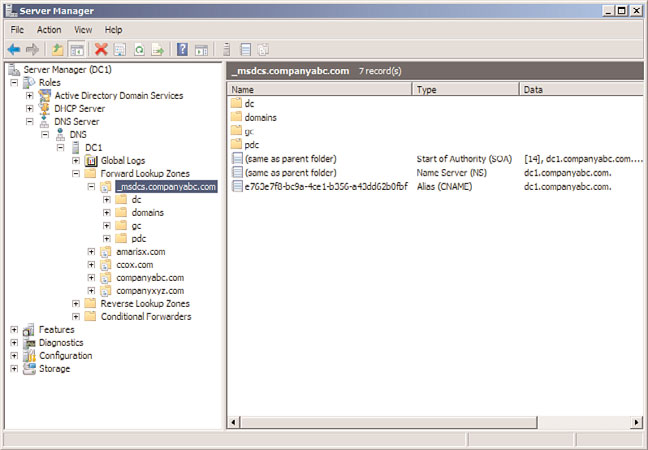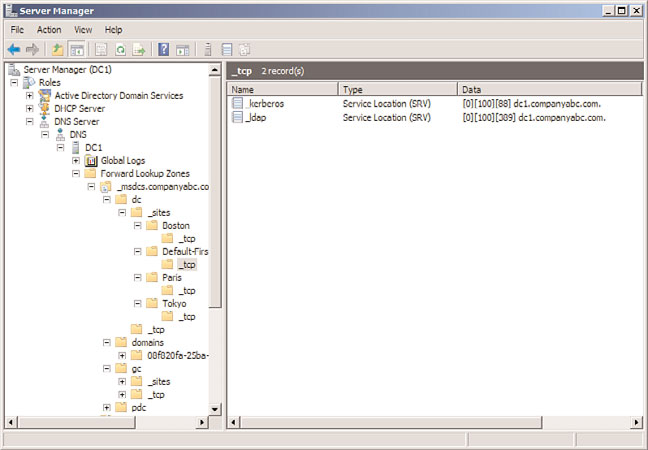Windows Server 2008 R2 Unleashed (63 page)
Read Windows Server 2008 R2 Unleashed Online
Authors: Noel Morimoto
server. If the IP address of that server changed, the DNS server updated its own entry in
ptg
DNS, but then other DNS servers within the domain were unable to successfully retrieve
updates from the original server because they were requesting from the old IP address.
This effectively left the original DNS server in an “island” by itself, hence the term.
Microsoft DNS fixed this problem in Windows Server 2003 and above. Windows Server
2008 R2 DNS first changes its host records on a sufficient number of other authoritative
servers within DNS so that the IP changes made will be successfully replicated, thus elimi-
nating this “island” problem. As a result, it is no longer necessary to point a root DNS
server to another DNS server for updates, as was previously recommended as a method of
resolving this issue.
Forest Root Zone for _msdcs
In Active Directory, all client logons and lookups are directed to local domain controllers
and global catalog servers through references to the SRV records in DNS. These SRV
records were stored in a subdomain to an Active Directory domain that is known as the
_msdcs subdomain.
10
In Windows Server 2008 R2, _msdcs is a separate zone in DNS, as shown in Figure 10.14.
This zone, stored in the application partition, is replicated to every domain controller that
is a DNS server. This listing of SRV records was moved mainly to satisfy the requirements
of remote sites. In Windows 2000, these remote sites had to replicate the entire DNS data-
base locally to access the _msdcs records, which led to increased replication time and

288
CHAPTER 10
Domain Name System and IPv6
reduced responsiveness. If you delegate the SRV records to their own zone, only this
specific zone can be designated for replication to remote site DNS servers, saving replica-
tion throughput and increasing the response time for clients.
ptg
FIGURE 10.14
_msdcs zone.
DNS in an Active Directory Domain Services
DNS is inseparable from Active Directory. In fact, the two are often confused for one
another because of the similarities in their logical structures.
Active Directory uses a hierarchical X.500-based structure that was designed to map into
the DNS hierarchy, hence the similarities. In addition, Active Directory utilizes DNS for all
internal lookups, from client logons to global catalog lookups. Subsequently, strong
consideration into how DNS integrates with Active Directory is required for those consid-
ering deploying or upgrading AD.
The Impact of DNS on Active Directory Domain Services
Problems with DNS can spell disaster for an Active Directory environment. Because all
servers and clients are constantly performing lookups on one another, a break in name-
resolution service can severely affect Active Directory functionality.
For this and other reasons, installing a redundant DNS infrastructure in any Active
Directory Domain Services implementation is strongly recommended. Even smaller envi-
DNS in an Active Directory Domain Services Environment
289
ronments should consider duplication of the primary DNS zone, and nearly as much
emphasis as is put into protecting the global catalog AD index should be put into
protecting DNS.
Security considerations for the DNS database should not be taken for granted. Secure
updates to AD-integrated zones are highly recommended, and keeping DHCP servers off a
domain controller can also help to secure DNS (see previous sections of this chapter for
more details on this concept). In addition, limiting administrative access to DNS will help
to mitigate problems with unauthorized “monkeying around” with DNS.
Active Directory Domain Services in Non-Microsoft DNS
Implementations
Active Directory Domain Services was specifically written to be able to coexist and, in fact,
utilize a non-Microsoft DNS implementation as long as that implementation supports
dynamic updates and SRV records. For example, AD will function in all versions of UNIX
BIND 8.1.2 or higher. With this point in mind, however, it is still recommended that an
organization with a significant investment in Microsoft technologies consider hosting
Active Directory DNS on Windows Server 2008 R2 systems because functionality and secu-
rity enhancements provide for the best fit in these situations.
For environments that use older versions of DNS or are not able (or willing) to host Active
ptg
Directory clients directly in their databases, Active Directory DNS can simply be delegated
to a separate zone in which it can be authoritative. The Windows Server 2008 R2 systems
can simply set up forwarders to the foreign DNS implementations to provide for resolu-
tion of resources in the original zone.
Using Secondary Zones in an AD DS Environment
Certain situations in Active Directory require the use of secondary zones to handle specific
name resolution. For example, in peer-root domain models, where two separate trees form
different namespaces within the same forest, secondaries of each DNS root were required
in Windows 2000 to maintain proper forestwide synchronization.
Because each tree in a peer-root model is composed of independent domains that might
not have security privileges in the other domains, a mechanism will need to be in place to
allow for lookups to occur between the two trees. The creation of secondary zones in each
DNS environment will provide a solution to this scenario, as illustrated in Figure 10.15.
Windows Server 2008 R2 now has the option of replicating these separate trees to all DNS
servers in the forest, reducing the need for secondary zones. Replicating secondary zones
10
outside of a forest is still sometimes necessary, however. Conditional forwarding and stub
zones can also be used in certain cases to achieve a similar result without the need for data
replication.
SRV Records and Site Resolution
All Active Directory Domain Services clients use DNS for any type of domain-based
lookups. Logons, for example, require lookups into the Active Directory for specific SRV
records that indicate the location of domain controllers and global catalog servers.
290
CHAPTER 10
Domain Name System and IPv6
CompanyABC’s AD Forest
abcroot.local
companyabc.com
Domain DNS
Domain DNS
Server
Server
abcroot.local
companyabc.com
AD-Integrated
Zone
AD-Integrated
Zone
Transfers
Zone
companyabc.com
abcroot.local
Secondary
Secondary
Zone
Zone
ptg
FIGURE 10.15
Peer-root domain DNS secondary zones.
Windows Server 2008 R2, as previously mentioned, divides the location of the SRV
records into a separate zone, which is replicated to all domain controllers that have DNS
installed on them.
Subdomains for each site are created in this zone; they indicate which resource is available
in those specific sites, as shown in Figure 10.16. In a nutshell, if an SRV record in the
specific site subdomain is incorrect, or another server from a different site is listed, all
clients in that site are forced to authenticate in other sites. This concept is important
because a common problem is that when Active Directory sites are created before they are
populated with servers, an SRV record from the hub location is added to that site subdo-
main in DNS. When a new server is added to those sites, their SRV records join the other
SRV records that were placed there when the site was created. These records are not auto-
matically deleted, and they consequently direct clients to servers across slow wide area
network (WAN) links, often making logon times very slow.
In addition to the site containers, the root of these containers contains a list of all domain
controllers in a specific domain. These lists are used for name resolution when a particular
site server does not respond. If a site domain controller is down, clients randomly choose
a domain controller in this site.

DNS in an Active Directory Domain Services Environment
291
FIGURE 10.16
Site-level SRV records.
ptg
GlobalNames Zone
In some cases, using a fully qualified domain name (FQDN) is not convenient for the end
users. This is especially true for novice users or in the case of very long domain names. A
user entering the uniform resource locator (URL) http://intranet.convergentcomputing.
com is quite likely to make a mistake in the typing. The WINS name resolution provides
relief from this, in that single-label names can be used instead. This allows the user to type
the URL http://intranet and still reach the desired resource.
However, with the advent of IPv6, WINS will no longer be supported as the new address-
ing is deployed throughout the organization. There are also many advantages of DNS over
WINS, including reducing administrative overhead, single name resolution repository,
security, and open standards.
Windows Server 2008 R2 provides a feature that was introduced in Windows Server 2008
to address this problem, specifically the GlobalNames zone (GNZ). This zone provides
single-label name resolution via a DNS zone, similar to WINS. The zone is a normal
forward lookup zone, albeit with a special name (GlobalNames), and is used by the DNS
10
server in a special way. If the DNS server is unable to resolve an address in its local zones,
it will then resolve the single-label address against the GlobalNames zone.
The GNZ holds out the promise of finally doing away with WINS and NetBIOS naming.
292
CHAPTER 10
Domain Name System and IPv6
To configure the GlobalNames zone, execute the following steps:
1. Launch Server Manager.
2. Expand the Roles, DNS Server, and DNS nodes, and then select the server name.
3. Select the Forward Lookup Zones node.
4. Select Action, New Zone.
5. Click Next on the Welcome page.
6. Select Primary Zone and make sure that the Store the Zone in Active Directory check
box is checked. Click Next.
7. Select To All DNS Servers in This Forest, and click Next.
8. Enter the Zone name GlobalNames and click Next.
9. Leave the default Dynamic Update setting and click Next.
10. Click Finish to create the zone.
11. Open a command prompt and enter the command dnscmd /config
/EnableGlobalNamesSupport 1. The message “Registry property
EnableGlobalNamesSupport successfully reset” should be returned. This command
must be run on each DNS server that is expected to resolve GlobalNames, regardless
of if the zone is replicated to them already.
ptg
Now the GlobalNames zone is ready to respond to queries. For any server that needs to
respond to single-label queries, enter a CNAME record in the GlobalNames zone with the
appropriate FQDN for the resource. The DNS server will try the GlobalNames zone after
trying other local zones.
Much has been written about the complexity of DNS, and even more confusion and
misconceptions have been written about it. In truth, however, DNS structure is logical, so
you can easily troubleshoot it, if you use the proper tools and techniques. A good grasp